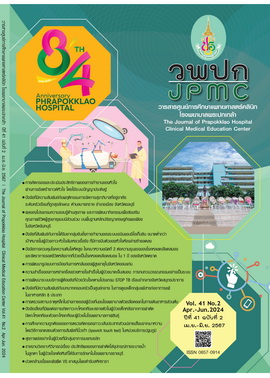Development Model of Fall Prevention among Elderly People in Khon Kaen Province
Main Article Content
Abstract
BACKGROUND: The elderly are at a significantly increased risk of falls, and there is currently no clear model for preventing falls among the elderly.
OBJECTIVES: 1) To study the situation of falls among the elderly, and 2) to develop and study the effectiveness of fall prevention models for the elderly.
METHODS: This study used a research and development (R&D) approach in 4 phases. Phase 1 involved studying the situation of falls among 330 elderly by randomly selected, while Phase 2 created fall prevention models for the elderly. Phase 3 investigated and developed the fall prevention models among the elderly, and Phase 4 involved experimentation and evaluation using both experimental and control groups, with each comprising 30 individuals. The research tools used in the study included 1) a questionnaire concerning the factors related to falls among the elderly, 2) a focus group discussion guide, 3) self-assessment of the ability to perform daily activities, 4) a mini-mental state examination –Thai version, 5) a Thai falls risk assessment test (Thai-FRAT) developed for community-dwelling Thai elderly, and 6) a questionnaire concerning the perceptions and fall prevention behaviors of the elderly.
RESULTS: The fall prevention model for the elderly consists of 1) analyzing the problem jointly, 2) promoting health literacy regarding falls among the elderly, 3) organizing health promotion activities within elderly clubs, and 4) supporting budgets and resources for fall prevention among the elderly. It was found that the overall perceived risk of falls and prevention behaviors among the elderly in the experimental group had significantly higher average scores than the control group (p<0.01).
CONCLUSIONS: The study results indicate that the process of developing a fall prevention model for the elderly is advantageous and can effectively enhance fall prevention among the elderly.
Article Details

This work is licensed under a Creative Commons Attribution-NonCommercial-NoDerivatives 4.0 International License.
References
Ministry of Public Health. Medical guidelines for preventing and assessing fall in the elderly. Nonthaburi: Institute Of Geriatric Medicine; 2019.
KhonKaen Provincial Public Health Office. Report on key public health performance. documents for regular examination round 2/2022.KhonKaen: KhonKaen Provincial Public Health Office; 2023.
KhonKaen Provincial Public Health Office. Annual report 2021. KhonKaen: KhonKaen Provincial Public Health Office; 2022.
Stretcher V, Rosenstock IM. The health belief model. In: Glanz Karen, Lewis FM, Rimer BK. Health behavior and health education: theory, research, and practice. 2nd ed. San Francisco: Jossey-Bass; 1997. p. 31-44.
Ministry of Public Health. Guide to screening and assessment of the elderly. 2nd ed. Nonthaburi: Ministry of Public Health; 2015.
Pongpaew S. Predictive factors of fall prevention behaviors among older adults, Nontaburi province [Thesis]. Nakhon Pathom: Mahidol University; 2013.
Akkhanan T, Srimaksook K, Wongsrisung T, Siripaiboon C, Duangchinda A, Pilaporn S. Factors associated with behaviors of falls prevention among thai elderly in the community at Doem Bang Nang Buat, SuphanBuri province. KKU Journal for Public Health Research 2021:14(4);72-89.
Baurangthienthong S, Yindee O. The study among risk of falls, fear of falls and managements of prevention for falls in client of geriatric clinic. Vajira Nursing Journal 2021;23(2):30-43.

